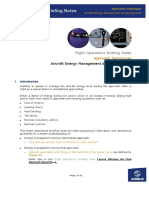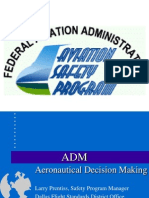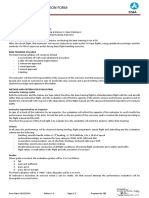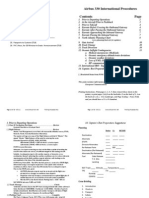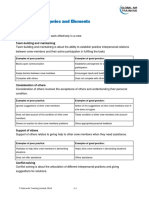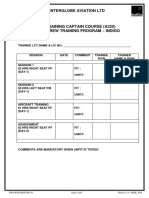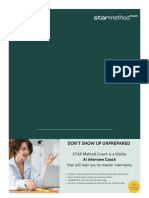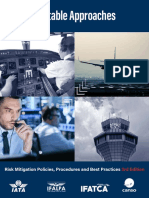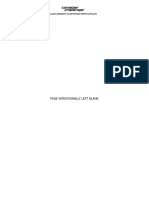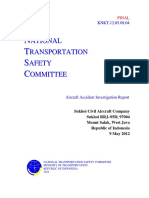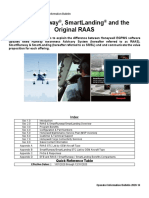0 ratings0% found this document useful (0 votes)
382 viewsMonsoon Operations Mel Weather Operations
Monsoon Operations Mel Weather Operations
Uploaded by
ja-fferThis document from the Government of India's Civil Aviation Department outlines new requirements for pilot training and certification to operate aircraft during India's monsoon season. It requires all pilots to complete ground training on monsoon meteorology and aircraft performance in adverse weather. New commanders must have prior monsoon experience as a co-pilot, complete simulator training on monsoon operations, and gain 100 hours as pilot-in-command before flying solo during monsoons. Pilots new to an aircraft type must also complete simulator training and checks even if they have prior monsoon experience. The goal is to reinforce safe operating practices and address human factors that have contributed to past accidents during the challenging conditions of India's monsoon.
Copyright:
© All Rights Reserved
Available Formats
Download as PDF, TXT or read online from Scribd
Monsoon Operations Mel Weather Operations
Monsoon Operations Mel Weather Operations
Uploaded by
ja-ffer0 ratings0% found this document useful (0 votes)
382 views8 pagesThis document from the Government of India's Civil Aviation Department outlines new requirements for pilot training and certification to operate aircraft during India's monsoon season. It requires all pilots to complete ground training on monsoon meteorology and aircraft performance in adverse weather. New commanders must have prior monsoon experience as a co-pilot, complete simulator training on monsoon operations, and gain 100 hours as pilot-in-command before flying solo during monsoons. Pilots new to an aircraft type must also complete simulator training and checks even if they have prior monsoon experience. The goal is to reinforce safe operating practices and address human factors that have contributed to past accidents during the challenging conditions of India's monsoon.
Copyright
© © All Rights Reserved
Available Formats
PDF, TXT or read online from Scribd
Share this document
Did you find this document useful?
Is this content inappropriate?
This document from the Government of India's Civil Aviation Department outlines new requirements for pilot training and certification to operate aircraft during India's monsoon season. It requires all pilots to complete ground training on monsoon meteorology and aircraft performance in adverse weather. New commanders must have prior monsoon experience as a co-pilot, complete simulator training on monsoon operations, and gain 100 hours as pilot-in-command before flying solo during monsoons. Pilots new to an aircraft type must also complete simulator training and checks even if they have prior monsoon experience. The goal is to reinforce safe operating practices and address human factors that have contributed to past accidents during the challenging conditions of India's monsoon.
Copyright:
© All Rights Reserved
Available Formats
Download as PDF, TXT or read online from Scribd
Download as pdf or txt
0 ratings0% found this document useful (0 votes)
382 views8 pagesMonsoon Operations Mel Weather Operations
Monsoon Operations Mel Weather Operations
Uploaded by
ja-fferThis document from the Government of India's Civil Aviation Department outlines new requirements for pilot training and certification to operate aircraft during India's monsoon season. It requires all pilots to complete ground training on monsoon meteorology and aircraft performance in adverse weather. New commanders must have prior monsoon experience as a co-pilot, complete simulator training on monsoon operations, and gain 100 hours as pilot-in-command before flying solo during monsoons. Pilots new to an aircraft type must also complete simulator training and checks even if they have prior monsoon experience. The goal is to reinforce safe operating practices and address human factors that have contributed to past accidents during the challenging conditions of India's monsoon.
Copyright:
© All Rights Reserved
Available Formats
Download as PDF, TXT or read online from Scribd
Download as pdf or txt
You are on page 1of 8
GOVERNMENT OF INDIA
CIVIL AVIATION DEPARTMENT
OFFICE OF THE
DIRECTOR GENERAL OF CIVIL AVIATION
OPP. SAFDARJUNG AIRPORT, NEW DELHI 110 003
TELEPHONE: 091-011-24635261
24644768
FAX: 091-011-24644764
TELEX: 31-74127
TELEGRAMS: AIRCIVIL
Reference:
No.:
Dated:
AV.22024/3/2007-FID
6
th
May 2010
OPERATIONS CIRCULAR 9 of 2010
Subject: ADVERSE WEATHER OPERATIONS - MONSOON OPERATIONS
1. Background
The meteorological term Monsoon is traditionally defined as a seasonal
reversing wind pattern accompanied by seasonal changes in precipitation. It is
now also used to describe seasonal changes in atmospheric circulation and
precipitation. The major monsoon systems of the world include the West
African and Asia-Australian monsoons. The North and South American
monsoons, however, comprise an incomplete wind reversal.
In hydrology, monsoon rainfall is considered to be that which occurs in any
region that receives the majority of its rain during a particular season. This
allows other regions of the world to qualify as monsoon regions as well.
The term "monsoon" being used in the context of this circular refer to the big
seasonal winds that blow from the Arabian Sea and Bay of Bengal in the
southwest bringing heavy rainfall to the area. India experiences a Monsoon
season every year which, due to the countrys geographical location and
geological characteristics, is unique in extent, intensity and coverage.
The season usually lasts from June to September and is dominated by the
humid southwest summer monsoon, which slowly sweeps across the country
beginning in May or early June. Monsoon rains begin to recede from North
India at the beginning of October.
Page 1 of 1
OPERATIONS CIRCULAR 9 OF 2010 6
TH
MAY 2010
The actual dates of arrival and departure of the Indian Monsoon are forecast
each year by the India Meteorological Department (IMD) of the Ministry of
Earth Sciences. These can be perused on the website of IMD.
This Circular supersedes Operations Circular 10 of 2009.
2. Purpose:
Despite the annual occurrence and predicted regularity of the Indian
Monsoon, aviation incidents/ accidents occur every year Analysis has shown
that most of the incidents and accidents, that have occurred, were not
generally attributable to inadequacies in aircraft performance but occurred
mostly due to various deficiencies/shortcomings of the human element.
Operating techniques applicable to each aircraft, under various generic
adverse weather conditions, exist in flight manuals and must be adhered to.
However, to ensure an enhanced level of safety, the reinforcement of these
operating practices in the context of the Indian Monsoon with relevant,
specific and mandatory regulatory guidelines is essential.
3. Ground School for All Pilots prior to the Monsoon Season:
All Operators are to provide Ground School training to all their Pilots
irrespective of the fact that they may have flown during previous/ earlier
monsoon periods. This ground training shall cover, but not be limited to:
Aircraft Performance during Take-off and Landing with specific emphasis on
wet and contaminated runway conditions.
Calculation of Take-off and Landing field lengths and impact of individual
failure events, specific to aircraft type.
Indian Monsoon climatology
Techniques of Weather Avoidance.
Use of Weather Radar (type specific)
ALAR & Adverse Weather Tool Kit (earlier issued by DGCA). Additionally,
Operators not in possession of this shall seek this information through the
Flight Safety Foundations website. It is mandatory for all pilots to be given
training on this tool-kit and be individually issued the course contents and the
CD by the Operator. The module of ALAR Tool- kit shall be reviewed
alongwith recent experiences of related exceedances and incidents, every
year in the course of annual technical refresher.
Detailed briefing on CANPA approaches and procedures.
Page 2 of 2
OPERATIONS CIRCULAR 9 OF 2010 6
TH
MAY 2010
4. Release of New Commanders during Monsoons
All Operators are required to comply with the following requirements prior to
release of New Commanders to operate as PIC in monsoon conditions.
Release of Commanders who have operated as PIC in monsoons on any
other type prior to being released on subsequent type will also be governed
by this Circular.
5. Pilots who have obtained command rating for the first time:
Pilots who have obtained command rating for the first time are required to be
subjected to adverse weather/monsoon training and a check before being
released to fly as PIC in actual or forecast, adverse weather/ monsoon
conditions.
Note: Pilots, who have obtained their command rating on Jet Transport aircraft for
the first time, will fall under this category, even if they have flown earlier in
Turbo-prop aircraft.
The following additional criteria must be fulfilled:
(i) Should have operated as a P2 during a minimum of one monsoon
season prior to obtaining PIC rating on a new type.
(ii) Should have at least 100 hours PIC experience before being taken up
for Simulator training.
In cases where a PIC is short of the 100 hours requirement or his
endorsement has been obtained prior to or during adverse
weather/monsoons, the PIC may continue to fly from LHS with
Examiners/Instructors/Check Pilots during the monsoons till they
achieve 100 hours.
Note: For the purpose of this circular, 100 hours of PIC must include actual time in
the left seat and NOT include hours logged as a cruise captain.
Such flying would maintain his continuity and could be covered as P1
Performance Monitoring. On completion of 100 hours in such cases,
the pilot will comply with (iii) below.
(iii) (a) Two hours simulator session (in the form of LOFT) for adverse
weather operations covering all aspects of adverse weather
conditions likely to be encountered en-route and in terminal
areas covering aircraft performance related to wet/
contaminated runway conditions combined ith MEL despatch.
Increased emphasis on landing performance should be given
including assessment of landing distance required in reduced
Page 3 of 3
OPERATIONS CIRCULAR 9 OF 2010 6
TH
MAY 2010
braking effectiveness vs. actual Landing Distance Available
(Safety Margins). This will be followed by a check of two hours
in the simulator. Training and check for adverse weather
conditions to cover pre-monsoon, monsoon and post monsoon
period.
(b) Aircraft not having Simulator: Pilots of such Operators will
undergo Ground Training as given in Para 3 above. This training
should be arranged close as possible to the onset of Monsoon
season as forecast by the Indian Meteorology Department.
(iv) (a) In case of any adverse remarks during Simulator Check (Route
Check if applicable). Operators must arrange ground classes as
given in Para 3 above and simulator adverse weather training
followed by a Simulator Check (Route Check) by
Instructor/Examiner, before being cleared to operate
independently in adverse weather conditions/ monsoon period.
(b) Operators are to ensure that only pilots qualified as per this
circular are detailed for flights into adverse weather/ monsoon
affected regions.
(c) Aircraft not having simulators: Who have complied with para 5 iii
(b) above, should carry out two sector Route Check on aircraft.
The check has to be done in ACTUAL adverse weather/ rain
conditions for landing.
(d) Operators who do not have any Training Captains must detail
their qualified and experienced Pilots having a minimum of 500
Hrs PIC experience on type, to act as Co-pilots to Non-Monsoon
qualified Pilots and give guidance and help making decisions for
at least two sectors, actual adverse weather/monsoon
conditions (en-route and departure/ arrival airfield).
6. Pilots who have operated as PIC in Monsoons on another type:
Pilots with previous experience as PIC in Monsoons who have newly obtained
PIC rating on another type, must, after Ground Training as per Para 3 above,
comply with the following:
(i) Two hours simulator session (in the form of LOFT) for adverse weather
operations covering all aspects of weather conditions likely to be
encountered in monsoon (with related weather radar operations to
negotiate weather) including Aircraft Performance related to
wet/contaminated runway condition combined with MEL Dispatch. The
Pilots shall review the ALAR and Adverse Weather Tool Kit issued by
DGCA. . This training should be arranged as close as possible to the
onset of Monsoon season as forecast by the Indian Meteorology
Department. This will be followed by a 2 hours check in the Simulator
by Instructor/Examiner.
Page 4 of 4
OPERATIONS CIRCULAR 9 OF 2010 6
TH
MAY 2010
(ii) For Aircraft not having Simulator, two route checks to be carried during
the period as 5 (iv) (c) above.
7. General Conditions:
(i) Minimum total cockpit experience level of the PIC and the Co-Pilot should
not be less than 500 hours on type.
(ii) No supervised take-offs and landings in actual adverse weather/monsoon
conditions.
(iii) Approach briefing prior to Top of Descent shall include wet/contaminated
Landing Distance Required calculation. Scheduled Operators shall prepare a
quick analysis table for wet/contaminated LDR in view of the high cockpit
work-load environment.
(iv) A list of newly released commanders is forwarded to Flight Standards
Directorate, DGCA Hqrs., by all the Operators, by 15th of May of every year.
The names of Commanders released subsequent to this date till the onset of
pre-monsoon shall also be forwarded at the earliest.
(v) ILS approaches are to be preferred to non-precision approaches In case of
non-precision approaches, emphasis must be given on Constant Angle Non-
Precision Approaches (CANPA) Ref. Operations Circular 1 of
2005.Operators who have not introduced/ adopted CANPA in their flight
procedures are required to do so, alongwith flight crew training, at the earliest.
(vi) Greater emphasis on stabilized approaches (Refer Operations Circular No.
1 of 2003 on ALAR India Training Tool Kit and Circular No.9 of 2009
Standard Operating Procedures).
(vii) PANS OPS procedures for speed control in terminal areas must be followed.
(viii) Flight Manual limitations and Company SOPs must be strictly adhered to.
(ix) Go around procedure in case of wind shear, stall and recovery must be
reviewed as per Operations Circular 2 of 2001.
(x) All Operators are required to follow a non-reprisal policy for Go around and
Diversion,
(xi) Documentation about upset recovery technique for specific airplane must be
reviewed.
(xii) Full flap landing and adequate usage of Reverse thrust and consideration of
extra en-route/ terminal fuel computation shall be adhered to. (Type specific
manufacturers guidance accepted)
Page 5 of 5
OPERATIONS CIRCULAR 9 OF 2010 6
TH
MAY 2010
8. MEL Requirements
The following equipment shall be serviceable during adverse
weather/monsoon conditions operations in Indian Airspace.:
(a) (i) For aircraft requiring transponder and TCAS, both must be serviceable.
(ii) GPWS/EGPWS must be serviceable.
(iii) All deceleration devices including Thrust reversers must be
serviceable.
(iv) Anti-skid system must be serviceable.
(v) Wind shield wipers on both sides must be serviceable.
(vi) Anti icing and de-icing must be serviceable.
(vii) At least one Weather RADAR system must be serviceable.
(viii) Groove on tyres must be visible out of base stations.
The following items even though un-serviceable, could be accepted to return
direct to base station for maintenance (i.e. one landing only) subject to
acceptable weather conditions at departure and destination station.
(b) (i) Transponder/TCAS (not in RVSM airspace)
(ii) GPWS/EGPWS subject to all other instrumentation (to co-relate
position) being serviceable and flight crew to have satisfactory
terrain awareness.
(iii) One Thrust reverser provided other decelerating devices are
serviceable Subject to additional margin of minimum 1000 feet
to field length requirement for take-off and landing.
(iv) Anti-Skid system Subject to performance limitations.
(v) Wind-shield Wipers Subject to the PIC side (LHS) being serviceable.
(vi) Anti-icing and De-icing Subject to performance limitations.
Note: Clubbing of 8 (b) (iii) & (iv) is not permitted. So also, any system
degradation causing impact on Flight Controls/Thrust Reversal/Anti-
skid must be carefully weighed.
The above waivers to the MEL restrictions will in any case never be applied if
the MEL/ other regulatory requirements are not permitting the same for any
other specific operations.
For Simulator Monsoon Training and checks: the ADL must be revised to
reflect the following functions must be operative:
Weather Radar.
Appropriate Hi-Fidelity Special Effects for weather, turbulence/ wind shear,
wet/contaminated runway etc. as applicable.
Page 6 of 6
OPERATIONS CIRCULAR 9 OF 2010 6
TH
MAY 2010
Related Reading Material:
OPERATIONS:
Circular No. 3 of 1996 - Missed Approach by Pilots during Final
Approach to Land.
Circular No. 2 of 2001 - Operational Training & Procedures: Pilots.
Circular No. 4 of 2010 - Approach And Landing Accident Reduction
(ALAR) And Controlled Flight Into Terrain
(CFIT) Prevention Training.
Circular No. 1 of 2003 - ALAR India Training Tool Kit.
Circular No. 1 of 2009 Controlled Flight into Terrain.
& 11 of 1995
Circular No. 5 of 2002 - Enhanced Ground Proximity Warning
System (EGPWS) - Operation and
Training.
Circular No. 3 of 2009 - Reduced Effectiveness Of TAWS/EGPWS
Equipment.
Circular No. 1 of 2005 - Guidance to Operators for Conducting
Constant Angle Non-Precision
Approaches (CANPA).
Circular No. 9 of 2009 - Standard Operating Procedures.
Circular No. 6 of 2009 - Line Operational Simulations: Line-
Oriented Flight Training, Special Purpose
Operational Training.
Circular No. 8 of 2009 - Crew Resource Management Training.
Circular No. 2 of 2009 - Communication And Coordination Between
Flight Crew members And Cabin Crews.
Circular No. 3 of 2010 - Pilot's Spatial Disorientation.
Circular No. 3 of 2010 - Vertical Speed Indicator.
Circular No. 1 of 2010 - Mode Awareness and Energy State
Management Aspects of Flight Deck
Automation.
Circular No. 4 of 2009 - Dispatcher/ Flight Operations Officer
Resource Management Training.
AIR SAFETY :
Circular ASC 7 of 2005
Monsoon Circular 2007
Circular ASC 4 of 2002
References: -
1. Ramage, C., Monsoon Meteorology. International Geophysics Series, Vol. 15,
296 pp., Academic Press, San Diego, Calif. 1971.
2. Trenberth, .K.E., Stepaniak, D.P., Caron, J.M., 2000, The global monsoon as
seen through the divergent atmospheric circulation, Journal of Climate, 13,
3969-3993.
Page 7 of 7
OPERATIONS CIRCULAR 9 OF 2010 6
TH
MAY 2010
3. Glossary of Meteorology (June 2000). "Monsoon". American Meteorological
Society.
4. International Committee of the Third Workshop on Monsoons. The Global
Monsoon System: Research and Forecast.
Sd/-
(Capt. H Y Samant)
Chief Flight Operations Inspector
for Director General of Civil Aviation
Page 8 of 8
You might also like
- T2CAS Pilot's Guide Rev4Document258 pagesT2CAS Pilot's Guide Rev4Константин ПучковNo ratings yet
- Mmel Single Engine PDFDocument92 pagesMmel Single Engine PDFJP BrazalezNo ratings yet
- Familiarization Brieifing Turkistan (UAIT) 2022 JUL15 R1.0Document17 pagesFamiliarization Brieifing Turkistan (UAIT) 2022 JUL15 R1.0Derya Kadikash100% (1)
- ETOPSDocument8 pagesETOPSvikash_kumar_thakur100% (1)
- Jet Orientation CourseDocument1 pageJet Orientation CourseMarcelo NobregaNo ratings yet
- FlightSafety Hawker Beechcraft HS-125 Series PDFDocument12 pagesFlightSafety Hawker Beechcraft HS-125 Series PDFrg192100% (1)
- Lfus Phase 2Document36 pagesLfus Phase 2pyanmorNo ratings yet
- Lfus Phase 1Document25 pagesLfus Phase 1pyanmorNo ratings yet
- Avoiding Unstable Approaches Important Tips For AtcoDocument2 pagesAvoiding Unstable Approaches Important Tips For AtcoArjan Mukherjee100% (1)
- C194 Outline Rev 1-1Document10 pagesC194 Outline Rev 1-1hristoskydiveNo ratings yet
- RNP Approach Baro Vnav - 21012020 - 1417 - 12813Document36 pagesRNP Approach Baro Vnav - 21012020 - 1417 - 12813Mohammed AlsbeayNo ratings yet
- Train The Trainer Guide - FinalDocument118 pagesTrain The Trainer Guide - FinalGursewak MannNo ratings yet
- Command&Sa&Comm&Crm 1Document20 pagesCommand&Sa&Comm&Crm 1saban2139No ratings yet
- Airbus Safety Lib FLT Ops Sop Seq05Document5 pagesAirbus Safety Lib FLT Ops Sop Seq05Miguel Roy de GraciaNo ratings yet
- A Summary of Airline Weather Radar OperaDocument25 pagesA Summary of Airline Weather Radar OperaAirbus330 Airbus330No ratings yet
- Approach Techniques - Aircraft Energy MGTDocument11 pagesApproach Techniques - Aircraft Energy MGTmarko108No ratings yet
- AIRBUS PDP UPRT 1-Elements of Active Monitoring PDFDocument9 pagesAIRBUS PDP UPRT 1-Elements of Active Monitoring PDFAnders MardNo ratings yet
- Volcanic AshDocument15 pagesVolcanic Ashcaptmon351No ratings yet
- AIRBUS PDP UPRT 2-Flight Control Laws Summary PDFDocument5 pagesAIRBUS PDP UPRT 2-Flight Control Laws Summary PDFAnders MardNo ratings yet
- RVR e Conversion of VISDocument11 pagesRVR e Conversion of VISAndrea Rossi100% (1)
- 1 Flying A Go-Around Managing EnergyDocument5 pages1 Flying A Go-Around Managing EnergyFelipe Alberto González RoblesNo ratings yet
- Managing Interruptions and Distractions PDFDocument11 pagesManaging Interruptions and Distractions PDFLuis Eduardo Dos Santos100% (1)
- FSF Runway Excursions Report PDFDocument235 pagesFSF Runway Excursions Report PDFDinesh PoudelNo ratings yet
- Communication Failure ProcedureDocument6 pagesCommunication Failure Procedureeak_ya5875No ratings yet
- Aeronautical Decision MakingDocument49 pagesAeronautical Decision MakingWilliam XavierNo ratings yet
- A319 Manual Handling - Training ManualDocument21 pagesA319 Manual Handling - Training ManualEvgeni StanevNo ratings yet
- Take Off and Destination Alternate AerodromeDocument2 pagesTake Off and Destination Alternate AerodromeGilo95No ratings yet
- Flight Operations Briefing NoteDocument12 pagesFlight Operations Briefing Note윤창우No ratings yet
- Boeing Commercial Airplane Group Flight Operations Technical BulletinDocument4 pagesBoeing Commercial Airplane Group Flight Operations Technical BulletinArtem RassokhaNo ratings yet
- APPI Guide InstructorsDocument2 pagesAPPI Guide InstructorsLohrasp SuraliwalaNo ratings yet
- Base Training Evaluation Form: GeneralDocument3 pagesBase Training Evaluation Form: GeneralPhilMadezNo ratings yet
- Better Scanning Techniques Will Help Pilots Avoid Mid-Air CollisionsDocument4 pagesBetter Scanning Techniques Will Help Pilots Avoid Mid-Air Collisionsjunk5154No ratings yet
- IncapacitationDocument4 pagesIncapacitationCaptain MorganNo ratings yet
- HoldsDocument4 pagesHoldsCosmin Alexandru GrosariuNo ratings yet
- Proper Landing TechniqueDocument2 pagesProper Landing Techniqueanshit1No ratings yet
- AIRLINE COMMAND 25-02-2010 With PagenumbersDocument322 pagesAIRLINE COMMAND 25-02-2010 With Pagenumberstin2808No ratings yet
- l3 Airline Training Guides - Instructor v3Document7 pagesl3 Airline Training Guides - Instructor v3Tariq khosoNo ratings yet
- Notes For FCTMDocument10 pagesNotes For FCTMAmun RaNo ratings yet
- © Achilleas Gavriilidis 2020: Initial App Intermediate APP Final AppDocument29 pages© Achilleas Gavriilidis 2020: Initial App Intermediate APP Final AppAngelos Tzortzis100% (1)
- CRM Aspects in Incidents & AccidentsDocument10 pagesCRM Aspects in Incidents & AccidentsNHAN TRINHNo ratings yet
- Wake Turbulence Awareness and AvoidanceDocument8 pagesWake Turbulence Awareness and AvoidanceHENIGUEDRINo ratings yet
- 18pos06 Tailwind OperationsDocument6 pages18pos06 Tailwind OperationsSergio RomeroNo ratings yet
- Contingency Procedures NAT RegionDocument4 pagesContingency Procedures NAT RegionflyspannerrNo ratings yet
- Skill Test and Proficiency CheckDocument8 pagesSkill Test and Proficiency CheckPouryaNo ratings yet
- UPSET - Worldwide Rules and GuidanceDocument34 pagesUPSET - Worldwide Rules and Guidancepablo100% (1)
- Secondary StallsDocument3 pagesSecondary StallsMike Aguirre100% (1)
- A330 International Procedures PamphletDocument8 pagesA330 International Procedures PamphletA320CaptNo ratings yet
- CRMT Manual Edition 2 Chapter 1 NaviMindsDocument34 pagesCRMT Manual Edition 2 Chapter 1 NaviMindsgoal14No ratings yet
- NADPDocument1 pageNADPPatrik SobeciNo ratings yet
- NOTECHS Cats - Elements - EASA UpdateDocument7 pagesNOTECHS Cats - Elements - EASA UpdateHani BoudiafNo ratings yet
- AIRBUS PDP UPRT 4-Upset Recovery Techniques PDFDocument31 pagesAIRBUS PDP UPRT 4-Upset Recovery Techniques PDFAnders MardNo ratings yet
- AIRBUS PDP UPRT 3-Elements of Aerodynamics PDFDocument28 pagesAIRBUS PDP UPRT 3-Elements of Aerodynamics PDFAnders MardNo ratings yet
- Interglobe Aviation LTD: Igo/Ops/Form/Trg/16 Page 1 of 8 Effective: 01-APRIL-2018Document8 pagesInterglobe Aviation LTD: Igo/Ops/Form/Trg/16 Page 1 of 8 Effective: 01-APRIL-2018Aman VermaNo ratings yet
- Airline Transport Pilot (Atp) Exam Briefing Guide and Flight Test StandardsDocument10 pagesAirline Transport Pilot (Atp) Exam Briefing Guide and Flight Test StandardsRodrigo HalzenthNo ratings yet
- A320 Stall RecoveryDocument3 pagesA320 Stall RecoverylahirishrayanNo ratings yet
- AIRBUS PDP UPRT 5-Extreme Attitude Training PDFDocument35 pagesAIRBUS PDP UPRT 5-Extreme Attitude Training PDFAnders MardNo ratings yet
- UPRT - Aerodynamic Principles of Large Airplane Upsets MAR 16Document14 pagesUPRT - Aerodynamic Principles of Large Airplane Upsets MAR 16Sacha MilovanNo ratings yet
- Managing Threats and Errors During Approach and LandingDocument30 pagesManaging Threats and Errors During Approach and LandingCaroline Vidal100% (2)
- Low Vis ProceduresDocument20 pagesLow Vis ProceduresViktor GeNo ratings yet
- Pilot Interview Questions Answers Star Method GuideDocument11 pagesPilot Interview Questions Answers Star Method Guideetcheverria.rafaNo ratings yet
- A321 Memory Oral TestDocument18 pagesA321 Memory Oral TestDat NguyenNo ratings yet
- Citation Excel SpecDocument4 pagesCitation Excel SpecJuanOñateNo ratings yet
- Quic Reference Card 737 PDFDocument2 pagesQuic Reference Card 737 PDFMNo ratings yet
- AbreviDocument4 pagesAbreviItamar Ponciano SouzaNo ratings yet
- Sample Private Pilot Asel Practical Test ScenarioDocument8 pagesSample Private Pilot Asel Practical Test ScenarioIbrahim MedNo ratings yet
- Lecture 9 Ground Proximity Warning System GPWSDocument15 pagesLecture 9 Ground Proximity Warning System GPWSandrewnaskar1No ratings yet
- IATA Guidance Unstable Approaches PDFDocument52 pagesIATA Guidance Unstable Approaches PDFfriyeri100% (2)
- C17Document146 pagesC171860746No ratings yet
- KGP 560 & KGP 860: EGPWS (TAWS) For General AviationDocument2 pagesKGP 560 & KGP 860: EGPWS (TAWS) For General AviationloicfrevilleNo ratings yet
- CH03Document68 pagesCH03Andrew GoraNo ratings yet
- B737-CL Syllabus NewDocument34 pagesB737-CL Syllabus NewM.A.C RandyNo ratings yet
- Falcon 8x SB516Document13 pagesFalcon 8x SB516flyer fighterNo ratings yet
- Atpl Oral QBDocument3 pagesAtpl Oral QBNikhilesh 'gamble' IngaleNo ratings yet
- Page Intentionally Left Blank: Cl-604 Aircraft Illustrated Parts CatalogDocument8 pagesPage Intentionally Left Blank: Cl-604 Aircraft Illustrated Parts CatalogEmmanuel OnwukaNo ratings yet
- Test Paper Special VFR VT PrakashDocument10 pagesTest Paper Special VFR VT PrakashveeteeNo ratings yet
- Nav PDFDocument244 pagesNav PDFkirti prajapatiNo ratings yet
- Operation ProcedursDocument166 pagesOperation ProcedursWilliam TampiNo ratings yet
- B737 Operations ManualghyDocument272 pagesB737 Operations Manualghydpatterson1415No ratings yet
- Final Report Sukhoi Superjet 100 Accident, Released On Dec 18, 2012Document91 pagesFinal Report Sukhoi Superjet 100 Accident, Released On Dec 18, 2012REZA FAHLEFINo ratings yet
- Mmel 90Document54 pagesMmel 90Daniela GarciaNo ratings yet
- AC4020 Outline Rev 4-0Document54 pagesAC4020 Outline Rev 4-0stasNo ratings yet
- Flightpath DVD Transcripts FinalDocument9 pagesFlightpath DVD Transcripts FinalDeCarvalho Junior100% (1)
- Flight Operations Monitoring HandbookDocument106 pagesFlight Operations Monitoring HandbookEric MorganNo ratings yet
- Cap 768Document194 pagesCap 768Chabou RafikNo ratings yet
- SmartRunway SmartLanding Upgrade For Business AircraftDocument24 pagesSmartRunway SmartLanding Upgrade For Business AircraftwilmerNo ratings yet
- Harrier Manual Ground Ops ExtractDocument96 pagesHarrier Manual Ground Ops ExtractAnthony OgdenNo ratings yet
- Dvi, Hud, HMDDocument15 pagesDvi, Hud, HMDmohammed hashimNo ratings yet
- Navigation A-320 PDFDocument53 pagesNavigation A-320 PDFIman GhNo ratings yet
















